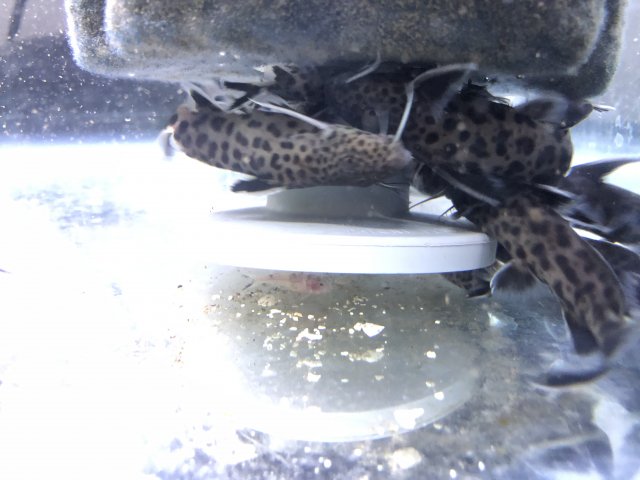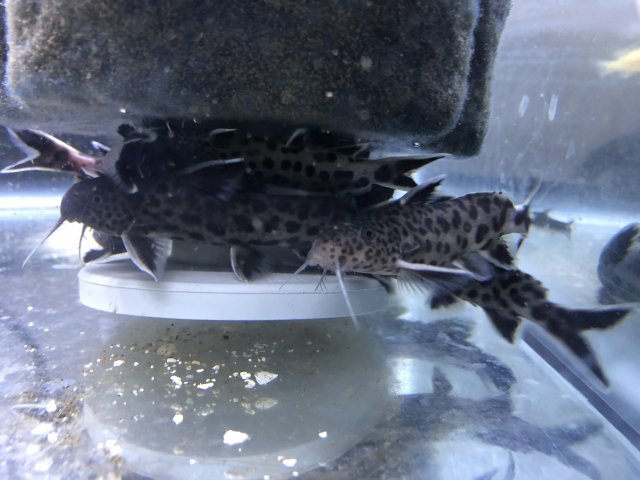MaybeI recall seeing piebald and leucistic nigrita and nigriventris for sale if not mistaken.
Albino Synodontis Petricola?
- Thread starter zmkm
- Start date
You are using an out of date browser. It may not display this or other websites correctly.
You should upgrade or use an alternative browser.
You should upgrade or use an alternative browser.
How to tell the difference between Petricola vs lucipinnis?Mmmmmmm, now that is something I do not recall seeing before. Seen a number of leucistic or albino synodontis but usually man made featherfins, nigrata, etc. Never seen leucistic or albino Petricola and home grown. I am aware it happens in the wild so odds were always for it to happen in captivity too.
it may be a mute point but I can't see the full parent, are you sure you have petricola and not lucipinnis?
Size of the spots on the body vs spots on the head.
petricola has very small spots,usually easily smaller than half the size of the body spots.
Lucipinnis head spots are larger, almost half the size of the body spots, occasionally 3/4 as big.
petricola has very small spots,usually easily smaller than half the size of the body spots.
Lucipinnis head spots are larger, almost half the size of the body spots, occasionally 3/4 as big.
99.9% of lucis used to be (are still?) sold as petri ... and for every petri 1000 lucis used to be sold.
Well, mine have very small spots on the head comparing to the spots on the bodies. I’ll try to take a picture.Size of the spots on the body vs spots on the head.
petricola has very small spots,usually easily smaller than half the size of the body spots.
Lucipinnis head spots are larger, almost half the size of the body spots, occasionally 3/4 as big.
How to tell the difference between Petricola vs lucipinnis?
Spot sizes are not the best indicator of species.
"Synodontis lucipinnis n. sp. is most similar to S. petricola but is distinguished by the lack of an axillary pore and the presence of light-colored windows at the bases of the rayed fins."
"The lack of an axillary pore distinguishes Synodontis lucipinnis from S. dhonti, S. grandiops, S. granulosus, S. multipunctatus, S. petricola, and S. tanganaicae. Synodontis lucipinnis is further separated from S. petricola by the presence of light colored windows at the bases of the rayed fins (with the exception of the caudal fin)"
See Figure 19 in link above for more info.
Figure 19. Holotype of Synodontis lucipinnis, SAIAB 77880, TL 97 mm, SL 78 mm.
A good read by Birger on planet catfish. https://www.planetcatfish.com/shanesworld/shanesworld.php?article_id=418
Last edited:
Thanks very much for the info. Very helpful. Although I can’t tell the axillary pore, there seem no light patch or window at the bases of the rayed fins on any of my fish.Spot sizes are not the best indicator of species.
"Synodontis lucipinnis n. sp. is most similar to S. petricola but is distinguished by the lack of an axillary pore and the presence of light-colored windows at the bases of the rayed fins."
"The lack of an axillary pore distinguishes Synodontis lucipinnis from S. dhonti, S. grandiops, S. granulosus, S. multipunctatus, S. petricola, and S. tanganaicae. Synodontis lucipinnis is further separated from S. petricola by the presence of light colored windows at the bases of the rayed fins (with the exception of the caudal fin)"
See Figure 19 in link above for more info.
Figure 19. Holotype of Synodontis lucipinnis, SAIAB 77880, TL 97 mm, SL 78 mm.
A good read by Birger on planet catfish. https://www.planetcatfish.com/shanesworld/shanesworld.php?article_id=418
Just curious, has anybody seen leucistic lucipinnis before somewhere? I just want to get more info on those mutants. Thanks






